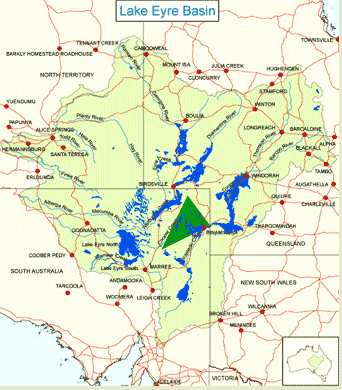“Ya gotta be jokin’ – No we’re not!” proclaims the Lake Eyre Yacht Club, the self-determined Worlds most exclusive Yacht Club, where only people who have actually skippered their own vessel on the lake surface can attain full membership. This becomes an extremely daunting task under the best of conditions. Additionally, conditions only allow it maybe once every couple of years.

The Lake Eyre Basin
Lake Eyre marks the lowest point of elevation in Australia at 15 metres (49 feet) below sea level. The larger Eyre Basin covers nearly one-sixth of the continent. Water entering the basin does not have an outlet to the sea in this endorheic basin. Rather, it flows away from the sea and towards the Australian interior for this very large portion of the continent. The minuscule portion of drainage that doesn’t soak into the soil or evaporate into the harsh desert atmosphere will find its way eventually to Lake Eyre in South Australia.

Lake Eyre often sits nearly empty but generally doesn’t dry completely. Most of the time it features a series large mucky, briny puddles. It sprawls across the playa, the salt-encrusted mudflats stretching in every direction to the horizon. High salinity typifies endorheic basins. The alkali salts eroding from the landscape have nowhere to flow except towards the lowest point of the watershed rather than the sea. The salt deposits of Lake Eyre appear quite visibly as massive white patches in the satellite image, below.
A Rare Treat
But every once in awhile the stars align, the winds shift, the weather changes just enough, maybe a La Niña pattern kicks-in with particular ferocity, the lake begins to awake and it expands exponentially over the nearly flat terrain. Our intrepid sailors get exited for times like these .
Annual monsoons sometimes dump unusually heavy rainfall on the intermittent rivers of the Queensland outback. It cannot be sucked into the ground or yanked back into the sky. The waters may flow through the Channel Country all the way to Lake Eyre. Also, locally heavy rains can contribute to the phenomenon, having less distance to travel and fewer opportunities to evaporate. Lake Eyre may rise 3 to 6 metres as a result of these particularly rainy periods. While that may not sound like a lot it provides sufficient coverage to create a vast inland sea.
To the Yachts!
The Yacht Club swings into action during these special times. Mariners head straight towards the waters from their clubhouse in Marree. Indeed, the Lake Eyre Yacht Club maintains a facility a hundred kilometres or so from its namesake. They wait patiently in the blazing heat and choking dust for those rare moments. Then they can demonstrate their nautical skills on open waters. I’m not sure whether I would call these sailors dedicated or deluded, perhaps a touch of both, but I applaud their enthusiasm.
Sailing on Lake Eyre presents more difficulty than one would imagine. The sailing itself isn’t the trouble assuming one pays attention to the weather. It’s the extreme amount of effort required to launch a boat and later return to dry land that presents an issue.
Considerations
First, consider the terrain. It’s brutally rugged, lightly traversed and totally unforgiving. People can die when their vehicles break or bog down if they don’t have sufficient provisions for a protracted stay. Next, there are only three spots where boats can actually launch and they’re not like the landings on a typical lake. Mariners need to pull their craft a kilometre or more to water’s edge unless they want to get stuck up to their axles in muck.
Finally prevailing winds change the nature and shape of the lake significantly because of its extreme shallowness. It is highly susceptible to seiches or “wind tides,” a condition not unlike hurricane storm surges, that push great volumes of water from one part of the basin to another. A sudden wind shift can leave a boater quickly stranded on the wrong side of a newly emptied lake bed, now separated from the launch by several kilometres.
The “yachts” must be adapted to the unique topographical characteristics of the lake. Vessels need to have a shallow draft to avoid grounding in the flat waters and they need to be light enough to be pulled long distances across the mud as necessary. Fiberglass canoes with homemade outriggers and masts are a common choice.
The surface of Lake Eyre remains below sea level even during the rainiest of times. Yacht Club members beg to differ up to a point. As they say, “while this is obviously quite correct, as mariners, the LEYC members like to sail on the sea rather than below it and so refer to depth as such – the amount of water above the lowest point in each of the basins.”
Nothing will stop these lake bed yachtsmen.
A Completely Different Subject
I saw an article in Smithsonian today that might interest some of you: Micronations of the World. “Explore these mock sovereign states fueled by local disputes, utopian idealism and the imaginations of a few eccentric individuals”

Leave a Reply